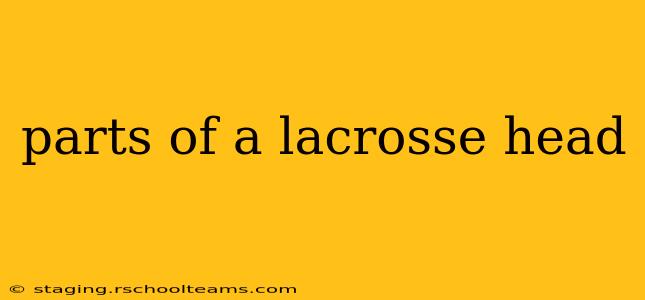Lacrosse, a fast-paced and dynamic sport, relies heavily on its specialized equipment. Understanding the intricacies of a lacrosse head is crucial for players of all levels, from beginners just learning to cradle to seasoned veterans striving for peak performance. This guide dives deep into the various parts of a lacrosse head, explaining their functions and how they contribute to the overall performance of the stick.
What are the main parts of a lacrosse head?
The lacrosse head is more than just a scoop; it's a precisely engineered piece of equipment with several key components working in harmony. The main parts include:
-
The Pocket: This is the most crucial part, formed by the mesh and the sidewall. The pocket's shape and depth directly impact how a player catches, cradles, and throws the ball. A deep pocket provides more control but may slow down shots, while a shallow pocket offers quicker releases but potentially less control. The pocket is where the ball resides during play.
-
The Sidewalls: These are the rigid, usually plastic, sides of the head that provide structure and support the mesh. They define the pocket’s shape and significantly influence the ball's release. Different sidewall designs offer variations in pocket depth and flexibility.
-
The Throat: The throat is the top, narrowest part of the head, where the shaft is attached. It's a crucial area affecting the overall balance and feel of the stick. A narrower throat can enhance control while potentially limiting the size of the pocket.
-
The Mesh: This is the netting woven into the head’s frame, creating the pocket. The mesh material, its knotting, and its tension directly influence the pocket's depth, hold, and release characteristics. Different meshes offer varying levels of durability and shot consistency.
-
The Channels (or Rails): These are the grooves running along the sidewalls. They provide additional structural support and can subtly influence ball retention within the pocket.
-
The Holes (or Eyelets): These are small openings on the sidewalls through which the mesh is laced. Their size and placement contribute to the pocket’s shape and overall performance.
What are the different types of lacrosse head pockets?
H2: What are the different types of lacrosse heads?
The type of lacrosse head you choose will depend heavily on your playing position and personal preferences. There are several types commonly used, each designed for a slightly different play style.
-
Offensive Heads: Typically feature deeper pockets for better ball control and enhanced passing ability, prioritizing accuracy and finesse over speed of release.
-
Defensive Heads: Usually have shallower pockets designed for quick checks and interceptions, emphasizing speed and disruption.
-
Midfield Heads: Often find a balance between offensive and defensive needs, offering a versatile option suitable for players who need both catching and quick release capabilities.
How do I choose the right lacrosse head for me?
Choosing the right lacrosse head is a personalized decision. Consider your position, playing style, and skill level. Experimenting with different heads and talking to experienced players or coaches can greatly aid in making an informed choice. The flexibility and feel of the pocket are key considerations.
What is the best lacrosse head?
There's no single "best" lacrosse head as individual preferences heavily influence this decision. The ideal lacrosse head varies depending on player position, playing style, and personal comfort.
How do I string a lacrosse head?
Stringing a lacrosse head is a skilled task that takes practice. Many resources exist online, including detailed videos and tutorials that can guide you through the process. If you're new to the game, it is best to consult an experienced stringer or attend a stringing clinic.
This comprehensive guide provides a solid foundation for understanding the intricacies of a lacrosse head. By understanding each component's function, players can make more informed decisions about equipment selection and optimize their performance on the field. Remember, the perfect lacrosse head isn't just about the equipment; it's about finding the right balance between control, release, and personal preference.
